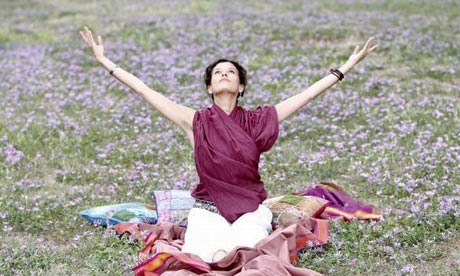
When I first heard about shakti dance, I hoped it would be an interesting amalgamation of yoga and dance that could teach me a thing or two and make me feel good. I'd tried various types of yoga in the past, but found myself losing interest after a few months. And although I liked dancing, my credentials were mainly limited to inebriated jigs at parties and the odd salsa class which just left me tied in knots.
What exactly is shakti dance?
It is best described as the yoga of dance. It embodies the intuitive flow of dance and the ancient wisdom of yoga, in particular kundalini yoga as taught by Yogi Bhajan. Transforming dance into a yogic practice has resulted in a discipline brimming with creative vitality. In the west dance has mostly become a form of entertainment, but historically it served as a way of connecting with ourselves and to each other, and bringing communities together in celebration. In shakti dance you can return to this human interaction and the simple joy of dancing. Each class is unique and unfolds spontaneously. Sara Avtar Olivier, a kundalini yoga trainer and lifelong dancer, is its founder and has been developing it since the early 1990s. It is the perfect exercise for balancing out a busy modern lifestyle.
What does 'shakti' mean?
Simply put, shakti is the Sanskrit word used to describe the force that animates all life. Olivier explains (albeit rather cryptically): "Shakti is the vibratory reality behind all existence." Shakti dance takes you "out of your head" and gets you "into your body". It connects you with a deep wellspring of creativity, and gives it an outlet for physical expression.
What happens in a class?
A shakti dance class is woven around a compilation of mantric music of different styles and tempos. A class starts with an opening mantra and builds through floor stretches to standing exercises and into free dance. Flowing asanas (yoga positions) gently stretch and deeply relax the body before leading into rhythmic, breath-coordinated standing movements and dance steps that induce high-energy states. The exercises work with the body's natural geometry and adhere to principles of harmonious movement, such as surrendering to gravity, working with rebound force and leading with the navel. The free dance is followed by a deep relaxation and the class rounds off with a seated or standing meditation, which is usually accompanied by a mantra.
When I started practising shakti dance I stared intently (and probably quite disconcertingly) at my teacher during the standing phase, frowning as I analysed her movements so I might copy them exactly. There was a lot to coordinate: different steps, arm movements, posture, breath and timing. But instead of getting flustered, my mind became completely focused and absorbed. Then something clicked, I stopped "thinking", and the movements revealed themselves. The more I practised, the more effortless it became.
Can it make me a better dancer?
Absolutely! You feel more coordinated and graceful as you dance your own dance. You learn to feel the music pulsing in the body and to respond to it in an authentic and original way. Learning different movements and steps during the initial phases is also a great way to extend your vocabulary of movement while keeping the mind fresh and alert.
What other benefits are there?
Olivier has taught many people over the years. She observes: "I repeatedly witness how people blossom as they gain newfound contact with, and awareness of, their own bodies in motion and the spirit that pervades them. Postures become more aligned, figures sleeker and movements more graceful. I often notice how students' facial contours change, becoming softer and more relaxed; they radiate more joy, and seem to be more at home in themselves. The act of dancing often takes on new dimensions as students experience a new freedom of movement led from deep within, while enjoying relaxing meditative states of mind."
Best if …
You're interested in yoga, dance or both, and want to bring out your creative side and expand your awareness.
Best avoided if …
You are looking to pump iron and sculpt your body.
Where can I try it?
Olivier is holding a weekend workshop at Moving Arts Base in London from 27-28 November. For further information on this, the 2011 UK Teacher Training, and classes in your area, visit shaktidance.co.uk.

